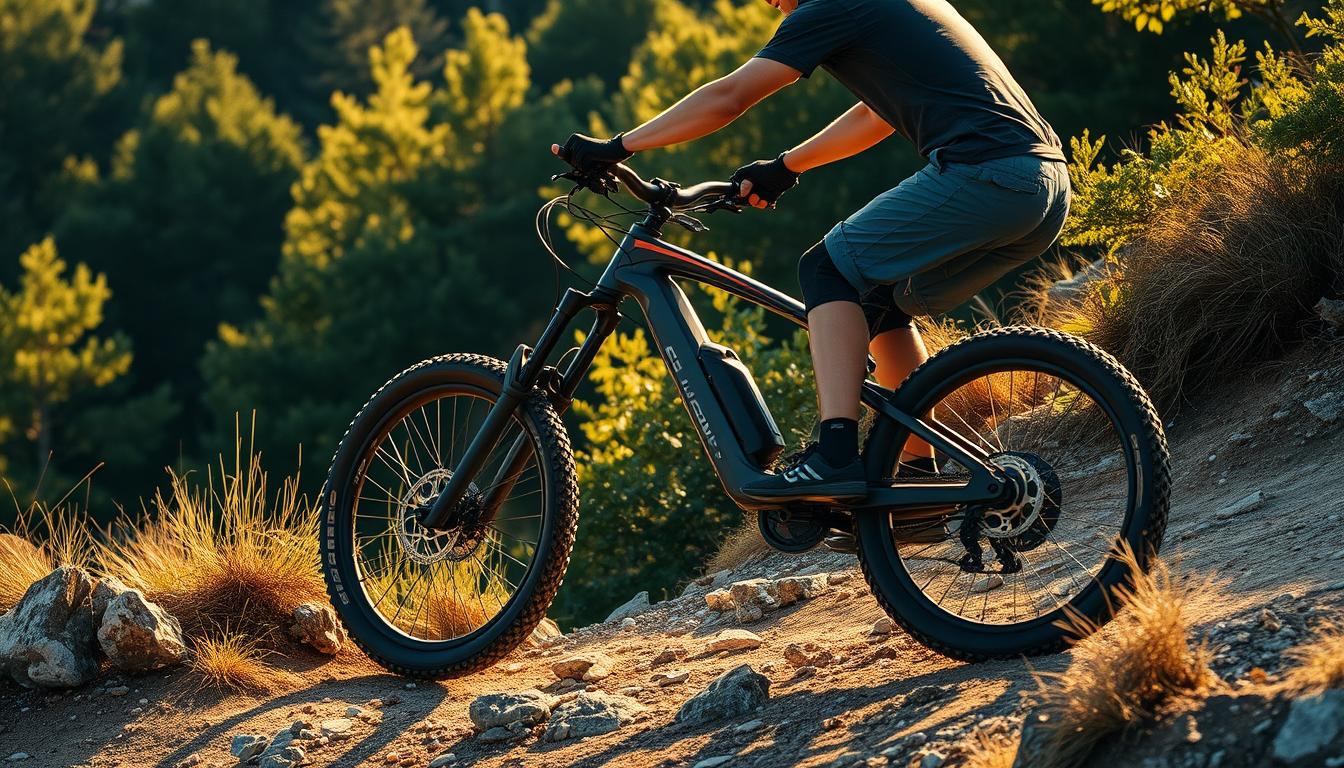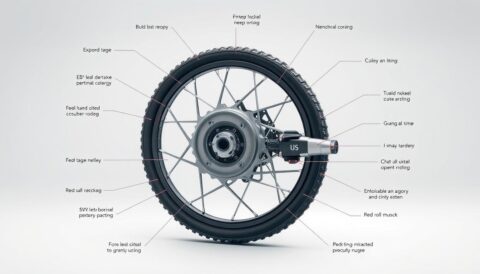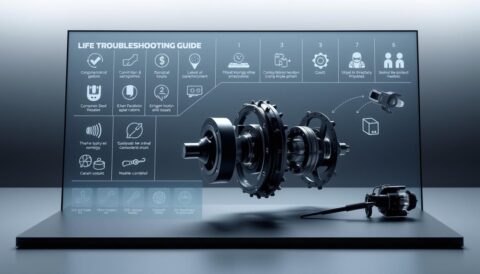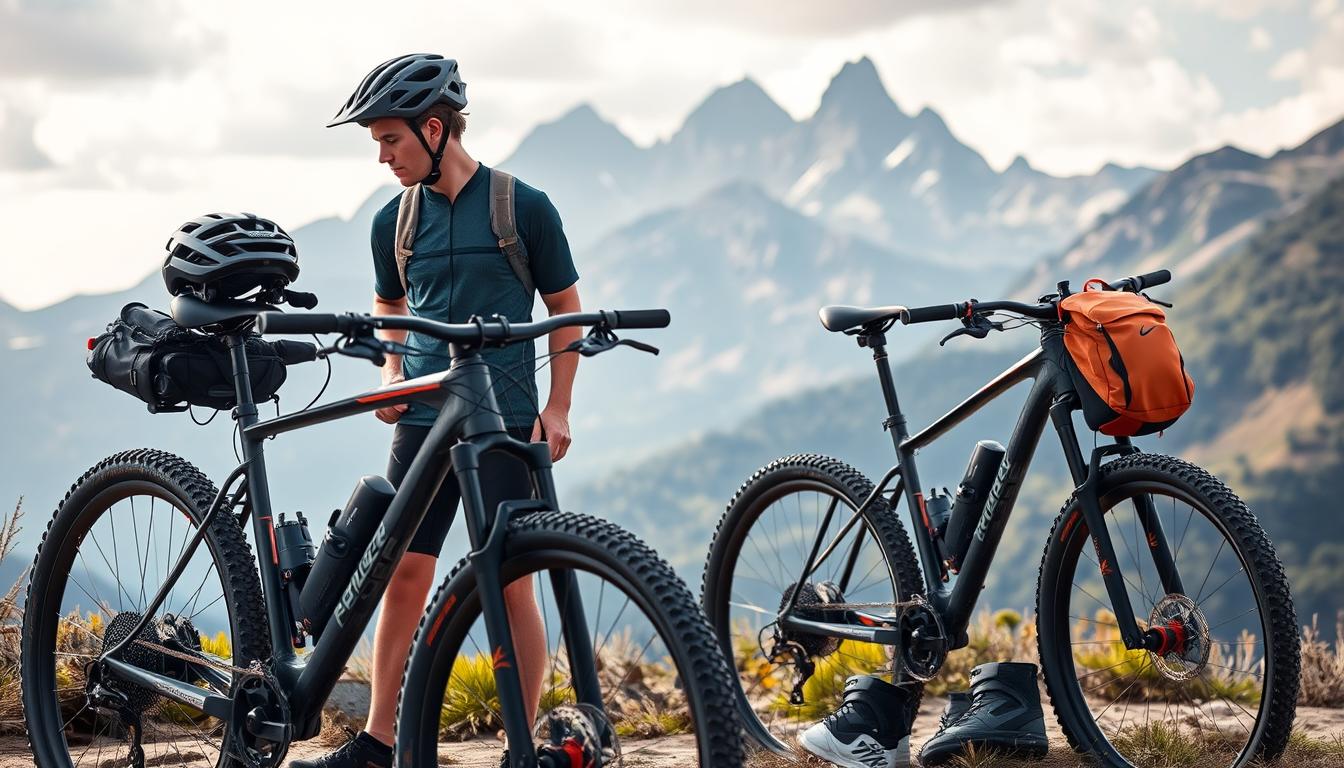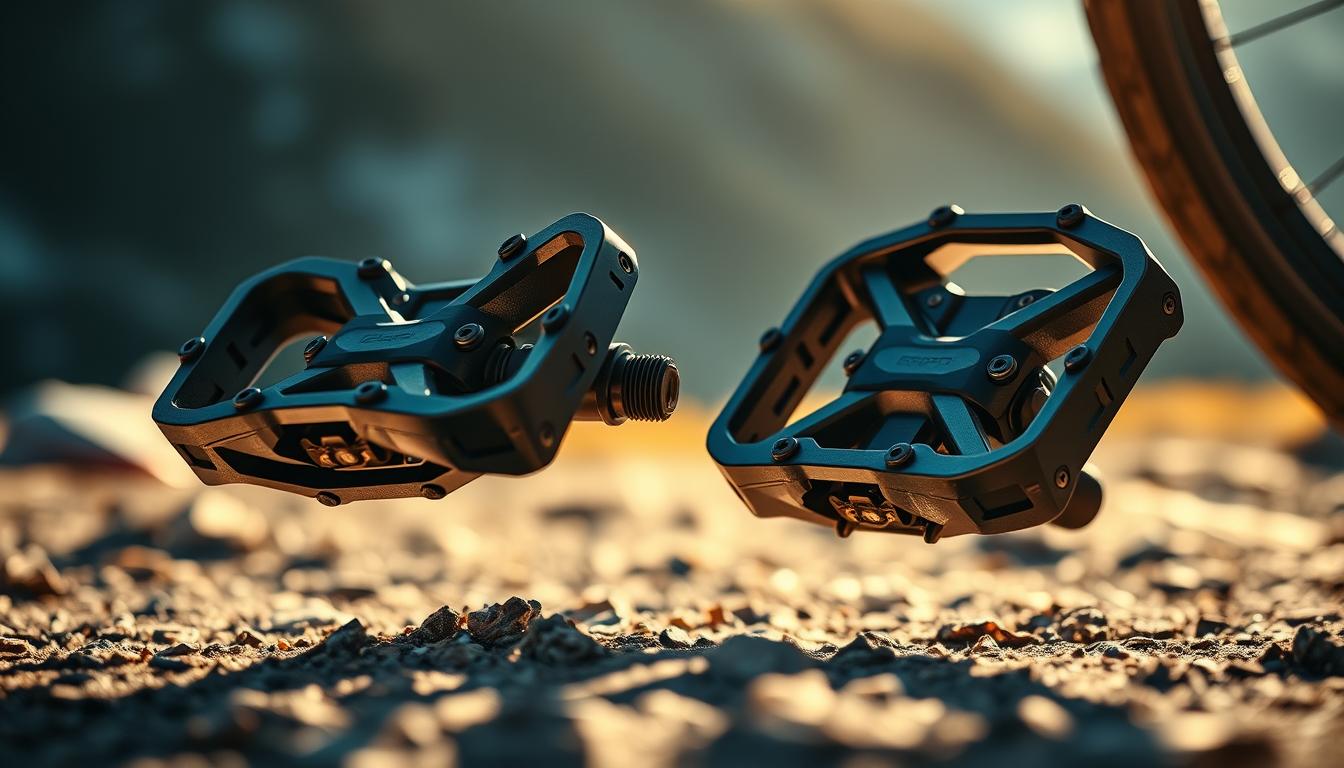For electric bike enthusiasts, especially in the UK, understanding how to maximise your bike’s battery range is crucial for enjoying longer, uninterrupted rides. Whether you’re tackling challenging mountain terrains or exploring scenic trails, the battery’s performance significantly impacts your overall experience. This guide will explore practical tips and insights to help you get the most out of your e-bike’s battery.
Battery capacity, measured in watt-hours (Wh), is a key factor in determining how far you can go on a single charge. Manufacturers often estimate range based on ideal conditions, but real-world performance can vary. For instance, a bike with a 518 Wh battery can achieve impressive distances, such as climbing 2,700 metres without needing a recharge1.
Riding modes play a significant role in extending your journey. Using Eco mode can substantially increase your range by reducing motor assistance. Additionally, maintaining consistent speed and planning routes with fewer elevation changes can conserve battery life2.
Factors such as tyre pressure and rider weight also influence battery efficiency. Higher tyre pressures, especially for road and gravel cycling, can enhance range, while reducing overall bike and rider weight decreases the motor’s power demand21.
This guide will delve into these aspects and more, providing expert advice on maintenance and performance optimization. By understanding these elements, you can enjoy more extended and exhilarating rides on your electric bike.
- Understand the impact of battery capacity and riding modes on range.
- Optimise tyre pressure and reduce weight for better efficiency.
- Learn maintenance tips and performance enhancements for extended rides.
Understanding eBike Battery Capacity and Range
For electric bike riders in the UK, grasping the concepts of battery capacity and range is essential to make the most of every journey. Whether cruising through scenic trails or tackling tough terrains, understanding these factors can significantly enhance your riding experience. This section delves into how battery capacity is calculated and the differences between theoretical and real-world range.
Calculating Battery Capacity and Conversion to Watt-Hours
Battery capacity is typically measured in watt-hours (Wh), which is the product of voltage (V) and amp-hours (Ah). For instance, a battery with 36V and 14Ah equates to 504 Wh3. However, real-world capacity is usually 80% of this figure, resulting in 403 Wh3.
Real-World Range vs Manufacturer Estimates
Manufacturers often provide ideal range estimates, but real-world performance varies due to factors like terrain and assist mode. For example, a 260Wh battery might offer around 25 miles in real conditions4, while a 520Wh battery could cover about 50 miles4.
| Battery Capacity (Wh) | Manufacturer Estimate (miles) | Real-World Range (miles) |
|---|---|---|
| 260 | 30-40 | 25 |
| 520 | 60-70 | 50 |
| 1000 | 70-80 | 60-70 |
Variables like assist mode and terrain significantly impact actual range. Urban environments may offer 20-50 miles, while mountainous terrains reduce this range due to higher resistance5.
Why Battery Efficiency is Crucial for E-Mountain Biking
Battery efficiency plays a vital role in enhancing your e-mountain biking experience. It ensures you can ride further and enjoy the trails without interruptions. This section explores how factors like rider weight, terrain, and mode settings impact your bike’s performance, and why Eco mode is a game-changer for extended rides.
Impact of Rider Weight, Terrain, and Mode Settings
Rider weight significantly affects battery efficiency. A study on Cube Electric Mountain Bikes revealed that an additional 10 kg can reduce range by up to 20%6. This makes maintaining a lightweight setup crucial for maximizing distance.
Terrain also plays a key role. Rough trails demand more power, draining the battery faster. For instance, a 520Wh battery might cover 50 miles on smooth roads but only 30 miles on technical terrain7.
Mode settings are another critical factor. Higher assist levels increase power consumption. Switching to Eco mode can extend your ride, as it reduces motor assistance and conserves energy8.
Benefits of Using Eco Mode for Extended Rides
Eco mode is designed to optimize battery life. By limiting motor output, it ensures you can ride longer on a single charge. This mode is particularly beneficial for UK riders tackling hilly or technical terrains.
Tests on e-mountain bikes show that consistent use of Eco mode can maintain efficiency, even on challenging trails. This mode helps riders enjoy extended adventures without worrying about running out of power6.
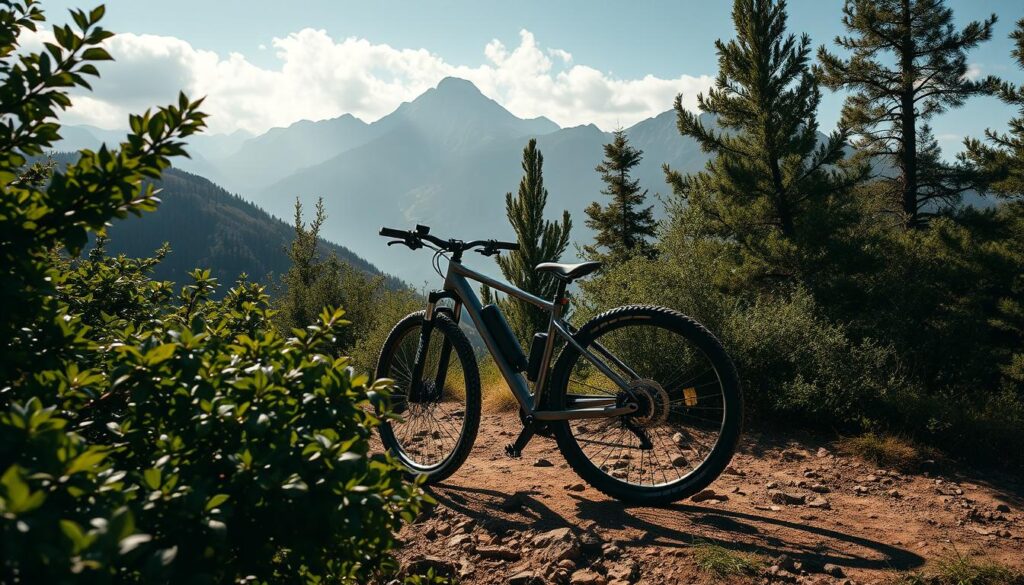
In conclusion, efficient battery use is central to prolonged, enjoyable mountain biking. By understanding how weight, terrain, and modes affect performance, and leveraging Eco mode, you can maximize your e-bike’s potential and explore more trails with confidence.
E-MTB Battery Range Guide: Essential Factors and Techniques
Choosing the right battery and motor combination is key to unlocking your e-mountain bike’s full potential. This section will guide you through the essential factors to consider for optimal off-road performance.
Selecting the Right Battery and Motor Combination
A suitable battery and motor setup ensures your e-bike performs well on challenging terrains. Compatibility is crucial—ensuring your battery pack matches your motor’s output for efficient power management9.
Battery capacity, measured in watt-hours (Wh), directly impacts your range. For instance, a 500Wh battery can offer around 62 km in Turbo mode and up to 100 km in Tour mode10. Pairing this with a high-torque motor like those from Bosch or Yamaha ensures consistent power delivery.
Factors Influencing Performance and Range
Weight and power output are critical. Lighter bikes with efficient motors consume less energy, extending your range. For example, a 400Wh battery on a mountain bike can provide about 25 km of range9.
Terrain and mode settings also play a role. Using Eco mode on hilly trails can significantly conserve battery life, allowing you to enjoy longer rides without recharging11.
Importance of a Balanced System
A well-balanced system enhances both efficiency and power management. On-board computer integrations and additional power units can further optimize your bike’s performance, ensuring you get the most out of every ride.
For more insights on battery and motor compatibility, visit Shimano’s eMTB battery basics.
Practical Techniques to Maximise Your E-MTB Battery Range
Optimising your e-MTB’s battery range is all about adopting simple yet effective habits. Whether you’re cruising through scenic trails or tackling tough terrains, these practical tips will help you extend your ride and enjoy the journey.
Optimising Charging Routines and Maintenance
To preserve your battery’s health, consider partial charging. Keeping your battery between 20% and 80% can help prolong its lifespan12. Additionally, using manufacturer-recommended chargers ensures safe and efficient charging. For example, a 400Wh battery typically charges in about 3½ hours, while a 700Wh battery may take up to six hours13.
Leveraging High-Quality Tyres and Regular Motor Servicing
High-quality tyres can significantly reduce rolling resistance. For instance, on-road tyres with low rolling resistance can enhance your range by up to 10%13. Always check tyre pressure before a ride, as under-inflated tyres can drain your battery faster. Regular motor servicing is also crucial—ensure your motor is free from debris and well-lubricated to maintain efficiency.
Regular inspections of your battery and motor can prevent performance issues. Look for signs of wear or damage and address them promptly. For more detailed advice on e-bike battery care, visit Cycling UK’s guide.
Investing in higher capacity batteries can offer more range, but consistent maintenance often provides better value. Proper storage is also key—keep your battery in a cool, dry place and avoid extreme temperatures to maintain its health12.
By integrating these practical techniques into your riding routine, you can enjoy longer, more exhilarating rides on your electric bike. Remember, a well-maintained e-MTB is not just about performance—it’s about the freedom to explore further.
Expert Tips for Enhancing Your Electric Bike Performance
For riders seeking to fine-tune their electric bike’s performance, understanding how to adjust pedal assist levels and ride modes is essential. These adjustments can significantly impact your bike’s efficiency and overall riding experience.
One of the most effective ways to enhance performance is by experimenting with pedal assist levels. Lower levels, such as Eco mode, conserve energy and are ideal for longer rides, potentially increasing your distance by up to 20%14. Conversely, higher levels like Turbo mode provide more power but drain the battery faster, especially on steep climbs14.
When it comes to ride modes, subtle adjustments can make a big difference. For instance, switching to Eco mode can extend your range by limiting motor output, making it particularly beneficial for hilly or technical terrains14. Additionally, maintaining a consistent pedaling cadence between 60-80 RPM can maximize battery efficiency14.
| Mode | Power Output | Battery Impact |
|---|---|---|
| Eco Mode | Low | Conserves energy, extends range |
| Trail Mode | Medium | Balances power and efficiency |
| Turbo Mode | High | Drains battery quickly, for steep climbs |
Monitoring your battery capacity indicators while riding is crucial. Keeping your battery between 20% and 80% can prolong its lifespan14. For more insights on conserving battery power during mountain rides, visit our guide.
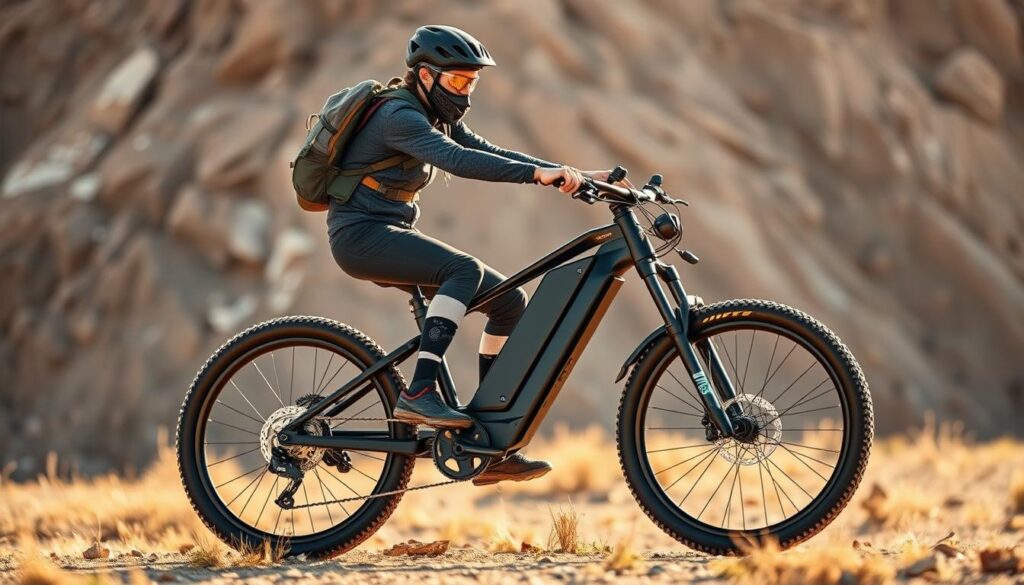
Conclusion
As you embark on your electric bike adventures in the UK, remember that maximizing your battery range is key to enjoying longer, uninterrupted rides. By understanding the impact of battery capacity, efficiency factors, and practical maintenance tips, you can significantly enhance your e-bike’s performance. Proper selection of battery and motor combinations, along with technique adjustments, can make a substantial difference in your bike’s range.
Using Eco mode and optimizing your charging routines are simple yet effective ways to conserve power. For instance, switching to Eco mode can extend your range by up to 20%, making it ideal for hilly or technical terrains15. Additionally, maintaining consistent pedaling and keeping your battery between 20% and 80% can prolong its lifespan15.
For UK riders, actionable takeaways include regular tyre inspections, reducing overall weight, and leveraging high-quality components. These practices not only improve efficiency but also ensure your bike is ready for any adventure. Remember, a well-maintained e-bike offers the freedom to explore further and enjoy more exhilarating rides.
Explore further guides and expert resources to delve deeper into electric bike performance. With these insights, you’re empowered to make informed decisions and maximize your e-bike’s potential. Happy trails!
FAQ
What factors affect the range of my electric bike?
The range of your electric bike is influenced by several factors, including rider weight, terrain type, assist mode, and battery capacity. Heavier riders or challenging terrains like mountains can reduce your range, while using eco mode can help extend it.
How does the battery capacity relate to the range?
Battery capacity, measured in watt-hours (Wh), directly impacts your e-bike’s range. A higher capacity battery generally means a longer range. However, this also depends on factors like power output and riding conditions.
What is the difference between eco mode and other ride modes?
Eco mode is designed to conserve battery life by limiting the motor’s power output. It provides a more efficient ride, making it ideal for longer trips or when you need to maximise your range.
How long does it take to charge an electric bike battery?
Charging time varies depending on the battery capacity and the charger’s wattage. Typically, it can take between 2 to 6 hours for a full charge. Always use the charger provided by the manufacturer for optimal performance.
Can I ride my electric bike in the rain?
Most modern e-bikes are designed to handle light rain, but it’s important to ensure your bike’s electrical components are water-resistant. Avoid riding in heavy downpours or deep water to protect your bike’s motor and battery.
How does terrain affect the battery range?
Riding on flat surfaces generally consumes less power than tackling hilly or mountainous terrains. Terrain resistance can significantly reduce your range, so it’s worth planning your route accordingly.
What maintenance is required for the battery?
To maintain your battery’s health, store it in a cool, dry place when not in use and avoid letting it completely drain. Regular charging cycles and avoiding extreme temperatures will help prolong its lifespan.
Can I upgrade my e-bike’s battery?
Yes, many e-bike batteries can be upgraded, but it’s crucial to use a compatible battery pack designed for your specific model. Consult your manufacturer or a professional to ensure a safe and efficient upgrade.
How does rider weight impact the range?
Heavier riders may experience a reduced range due to increased energy consumption. Using eco mode and ensuring your bike is properly maintained can help mitigate this effect.
What is the average range of an electric bike on a single charge?
The average range can vary widely, from around 20 to over 100 miles, depending on factors like battery capacity, terrain, and riding mode. Always refer to your manufacturer’s specifications for a more accurate estimate.
Source Links
- 11 tips and tricks to increase the battery range on your e-bike
- Electric bike range: Everything you need to know for longer rides
- eBike Range: What to Know and How to Extend It
- Battery Range Guide: Understanding Electric Bike Range & Batteries
- Electric Bike Batteries: Comprehensive Guide
- An overview of the most important eMTB battery systems
- Battery Range Guide: Understanding Electric Bike Range & Batteries
- Ebike batteries: capacity, charging and recycling explained
- Electric Bike Knowledge Articles | Raleigh UK
- How far can I ride on an e bike?
- Where to start with electric bikes: all you need to know
- Mastering Electric Bike Range: Tips, Factors, and Battery Expertise
- How to get the greatest range from your electric bike
- Unlock the Secrets to Maximizing Your E-Bike’s Range: Expert Tips and Tricks
- A Comprehensive Guide on E-Bike Batteries
